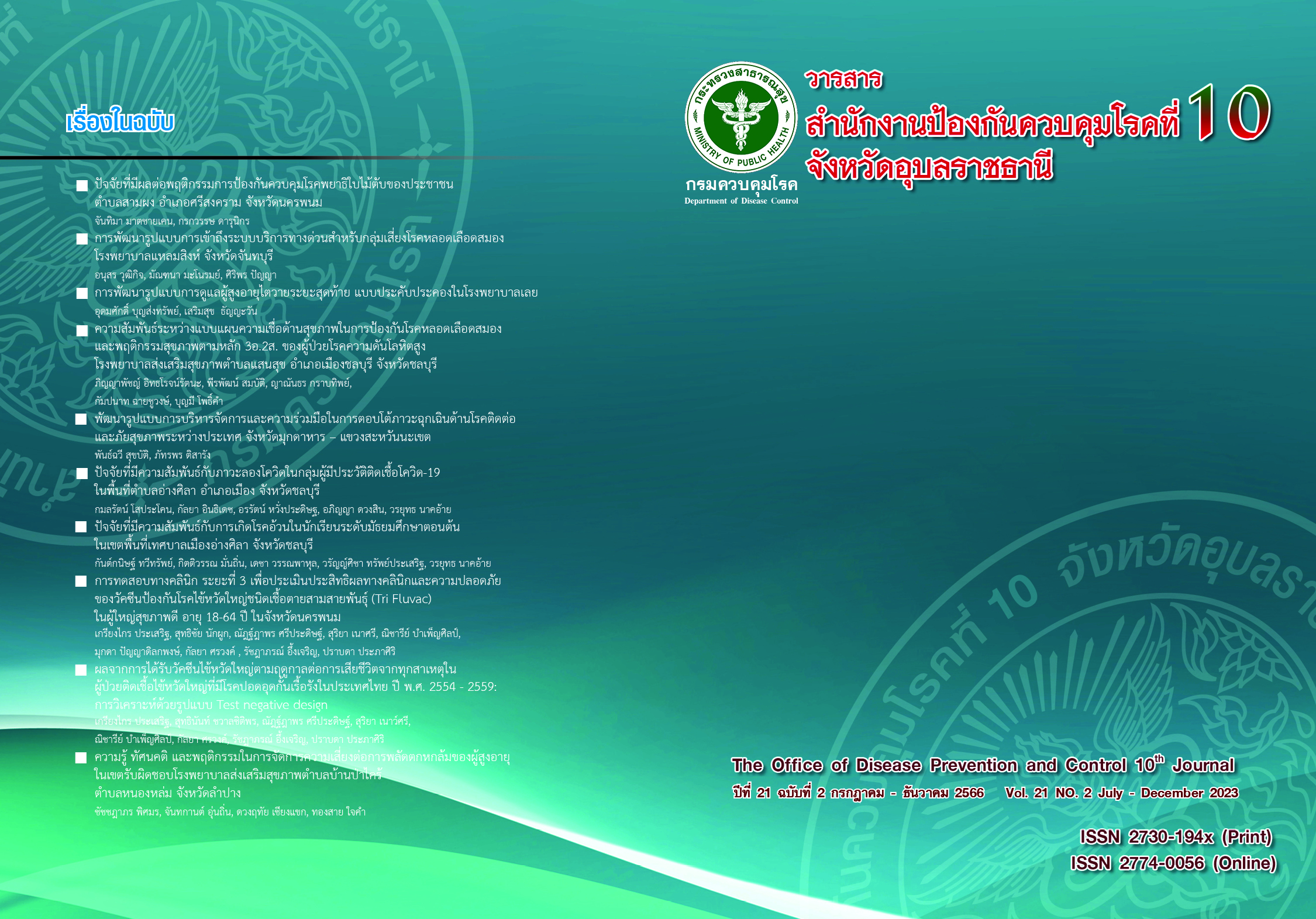การทดสอบทางคลินิก ระยะที่ 3 เพื่อประเมินประสิทธิผลทางคลินิกและความปลอดภัยของวัคซีนป้องกันโรคไข้หวัดใหญ่ชนิดเชื้อตายสามสายพันธุ์ (Tri Fluvac) ในผู้ใหญ่สุขภาพดี อายุ 18-64 ปี ในจังหวัดนครพนม
คำสำคัญ:
วัคซีนไข้หวัดใหญ่, การทดสอบทางคลินิกระยะที่ 3, ผู้ใหญ่บทคัดย่อ
การผลิตวัคซีนไข้หวัดใหญ่ได้เองในประเทศจะทำให้เกิดความยั่งยืนมีวัคซีนใช้เพียงพอ เกิดความมั่นคงด้านสุขภาพของประเทศชาติ อีกทั้งเป็นการเตรียมโครงสร้างพื้นฐานและประสบการณ์สำหรับการผลิตวัคซีนหากเกิดการระบาดใหญ่ การศึกษานี้เป็นการทดสอบทางคลินิก ระยะที่ 3 แบบสุ่มและมีกลุ่มควบคุมปกปิดสองทาง 3 กลุ่ม เพื่อประเมินประสิทธิผลทางคลินิกและความปลอดภัยของวัคซีนป้องกันโรคไข้หวัดใหญ่ชนิดเชื้อตายสามสายพันธุ์ ในช่วงฤดูกาลของไข้หวัดใหญ่ปี พ.ศ. 2562-2563 ในผู้ใหญ่สุขภาพดี อายุ 18-64 ปี จังหวัดนครพนม อาสาสมัครจำนวน 4,284 คน โดยสุ่มออกเป็น 3 กลุ่ม อัตราส่วน 3:3:1 อาสาสมัคร 1,836 คน ได้รับวัคซีนที่ผลิตโดยองค์การเภสัชกรรม (Tri Fluvac) อาสาสมัคร 1,836 คน ได้รับน้ำเกลือเลียนแบบวัคซีน (placebo) และอาสาสมัคร 612 คน ได้รับวัคซีนป้องกันโรคไข้หวัดใหญ่ที่มีขายในท้องตลาด (comparator) การศึกษานี้มีวัตถุประสงค์เพื่อประเมินค่าประสิทธิผลที่สัมบูรณ์ของ Tri Fluvac เมื่อเทียบกับ placebo และประสิทธิผลสัมพัทธ์กับวัคซีน comparator ต่อการติดเชื้อไข้หวัดใหญ่ โดยมีผลยืนยันทางห้องปฏิบัติการด้วยวิธี RT-PCR และประเมินความปลอดภัยหลังการฉีดวัคซีน 7 วัน จากการรายงานของอาสาสมัครและจากการติดตามเป็นระยะเวลา 1 ปี โดยในช่วง 1 ปี ระหว่างเดือนกันยายน 2562 ถึง เดือนตุลาคม 2563 อาสาสมัครทั้งหมด 4,284 คน เกิดการติดเชื้อไข้หวัดใหญ่ทั้งหมด 29 คน พบในผู้ที่ได้รับวัคซีน Tri Fluvac 10 คน และได้รับ placebo 19 คน คิดเป็นอัตราการติดเชื้อ 5.5/1,000 คน/ปี ในกลุ่ม Tri Fluvac และ 10.4/1,000 คน/ปี ในกลุ่ม placebo ได้ค่าประสิทธิผล 46.4 (95%CI= -22.0-76.5) เมื่อเปรียบเทียบกับ placebo เกิดเหตุการณ์ไม่พึงประสงค์และเหตุการณ์ไม่พึงประสงค์ร้ายแรงในอาสาสมัครที่ได้รับวัคซีน Tri Fluvac 175 คน (9.5%), placebo 177 คน (10.8%) และ comparator 66 คน (10.8%) พบว่าไม่มีความแตกต่างกัน เมื่อเปรียบเทียบระหว่าง Tri Fluvac และ comparator (p-value=0.437) สรุปได้ว่า Tri Fluvac เป็นวัคซีนที่มีความปลอดภัย ข้อจำกัดจากสถานการณ์การระบาดใหญ่ของ Covid-19 ทำให้เกิดรายงานการติดเชื้อในระบบทางเดินหายใจน้อย เป็นผลทำให้ไม่สามารถประเมินประสิทธิผลของวัคซีนได้
เอกสารอ้างอิง
Luliano AD, Roguski KM, Chang HH, Muscatello DJ, Palekar R, Tempia S, et al. Estimates of global seasonal influenza-associated respiratory mortality: a modelling study. Lancet 2018; 391(10127):1285-300.
World Health Organization. Influenza (Seasonal) [Internet]. 2018 [cited 2023 Oct 20]. Available from: https://www.who.int/en/news-room/fact-sheets/detail/influenza-(seasonal)
Rivetti D, Jefferson T, Thomas R, Rudin M, Rivetti A, Di Pietrantonj C, et al. Vaccines for preventing influenza in the elderly. Cochrane Database Syst Rev 2006; 19(3):CD004876.
World Health Organization. Vaccines against influenza WHO position paper - November 2012. Wkly Epidemiol Rec 2012; 87(47):461-76.
Friede M, Palkonyay L, Alfonso C, Pervikov Y, Torelli G, Wood D, et al. WHO initiative to increase global and equitable access to influenza vaccine in the event of a pandemic: supporting developing country production capacity through technology transfer. Vaccine 2011; 29 Suppl 1:A2-7.
Koch A, Röhmel J. Hypothesis Testing in the “Gold Standard” Design for Proving the Efficacy of an Experimental Treatment Relative to Placebo and a Reference. Journal of Biopharmaceutical Statistics 2004; 14(2):315-25.
Mutze T, Konietschke F, Munk A, Friede T. A studentized permutation test for three-arm trials in the 'gold standard' design. Stat Med 2017; 36(6):883-98.
FDA. Non-Inferiority Clinical Trials to Establish Effectiveness: Guidance for Industry [Internet]. [cited 2022 April 14]. Available from: https://www.fda.gov/media/78504/download
Rid A, Saxena A, Baqui AH, Bhan A, Bines J, Bouesseau M-C, et al. Placebo use in vaccine trials: Recommendations of a WHO expert panel. Vaccine 2014; 32(37):4708-12.
US Department of Health Human Services. Guidance for industry: clinical data needed to support the licensure of seasonal inactivated influenza vaccines. 1st edition. Rockville, MD: Center for Biologics Evaluation and Research; 2007.
Schumi J, Wittes JT. Through the looking glass: understanding non-inferiority. Trials 2011; 12(1):106.
US Department of Health Human Services. Non-inferiority clinical trials to establish effectiveness: guidance for industry (November 2016). 1st edition. Sliver Spring, MD: Center for Drug Evaluation and Research, Center for Biologics Evaluation and Research; 2017.
FDA. Guidance for Industry: Clinical Data Needed to Support the Licensure of Seasonal Inactivated Influenza Vaccines [Internet]. [cited 2023 April 13]. Available from: https://www.gmp-compliance.org/files/guidemgr/trifluvac.pdf
Kuster SP, Shah PS, Coleman BL, Lam PP, Tong A, Wormsbecker A, et al. Incidence of influenza in healthy adults and healthcare workers: a systematic review and meta-analysis. PLoS One 2011; 6(10):e26239.
Jones B, Jarvis P, Lewis JA, Ebbutt AF. Trials to assess equivalence: the importance of rigorous methods. BMJ: British Medical Journal 1996; 313(7048):36-9.
Smith PG, Morrow RH, Ross DA. Wellcome Trust-Funded Monographs and Book Chapters. Field Trials of Health Interventions: A Toolbox. 2nd edition. New York, NY: Oxford Universit; 2015.
FDA. Toxicity Grading Scale for Healthy Adult and Adolescent Volunteers Enrolled in Preventive Vaccine Clinical Trials [Internet]. [cited 2023 April 20]. Available from: https://www.fda.gov/media/73679/download
WHO. WHO surveillance case definitions for ILI and SARI [Internet]. [cited 2023 May 15]. Available from: https://www.who.int/teams/global-influenza-programme/surveillance-and-monitoring/case-definitions-for-ili-and-sari
Chittaganpitch M, Supawat K, Olsen SJ, Waicharoen S, Patthamadilok S, Yingyong T, et al. Influenza viruses in Thailand: 7 years of sentinel surveillance data, 2004–2010. Influenza and other respiratory viruses 2012; 6(4):276-83.
US Food Drug Administration. Guidance for industry. Toxicity grading scale for healthy adult and adolescent volunteers enrolled in preventive vaccine clinical trials. Fed Regist 2007; 72(187):54917.
Suntronwong N, Thongpan I, Chuchaona W, Budi Lestari F, Vichaiwattana P, Yorsaeng R, et al. Impact of COVID-19 public health interventions on influenza incidence in Thailand. Pathog Glob Health 2020; 114(5):225-7.
Chittaganpitch M, Supawat K, Olsen SJ, Waicharoen S, Patthamadilok S, Yingyong T, et al. Influenza viruses in Thailand: 7 years of sentinel surveillance data, 2004-2010. Influenza Other Respir Viruses 2012; 6(4):276-83.
Prasertbun R, Mori H, Mahittikorn A, Siri S, Naito T. Pneumonia, influenza, and dengue cases decreased after the COVID-19 pandemic in Thailand. Trop Med Health 2022; 50(1):27.
Center TNI. Report on changes in influenza strains [Internet]. [cited 2022 April 13]. Available from: http://www.thainihnic.org/influenza/main.php?option=report
Nakphook S, Patumanond J, Shrestha M, Prasert K, Chittaganpitch M, Mott JA, et al. Antibody responses induced by trivalent inactivated influenza vaccine among pregnant and non-pregnant women in Thailand: A matched cohort study. PLoS One 2021; 16(6):e0253028.
Grohskopf LA, Alyanak E, Broder KR, Blanton LH, Fry AM, Jernigan DB, et al. Prevention and Control of Seasonal Influenza with Vaccines: Recommendations of the Advisory Committee on Immunization Practices - United States, 2020-21 Influenza Season. MMWR Recomm Rep 2020; 69(8):1-24.
Mantel C, Chu SY, Hyde TB, Lambach P, Group IPI. Seasonal influenza vaccination in middle-income countries: Assessment of immunization practices in Belarus, Morocco, and Thailand. Vaccine 2020; 38(2):212-9.
Control TDoD. Covid-19 Vaccination Progress Report for March 10, 2023 [Internet]. [cited 2023 Oct 20]. Available from: https://ddc.moph.go.th/vaccine-covid19/diaryPresentMonth/03/10/2023
Health MoP. MOPH Immunization Center [Internet]. [cited 2022 June 5]. Available from: https://mohpromt.moph.go.th/mpc/mp-pf/mophic/
WHO. Vaccines against influenza: WHO position paper - May 2022. Wkly Epidemiol Rec 2022; 97(19):185-208.
ดาวน์โหลด
เผยแพร่แล้ว
รูปแบบการอ้างอิง
ฉบับ
ประเภทบทความ
สัญญาอนุญาต
ลิขสิทธิ์ (c) 2023 สำนักงานป้องกันควบคุมโรคที่ 10 จังหวัดอุบลราชธานี

อนุญาตภายใต้เงื่อนไข Creative Commons Attribution-NonCommercial-NoDerivatives 4.0 International License.
บทความที่ได้รับการตีพิมพ์เป็นลิขสิทธิ์ของ สำนักงานป้องกันควบคุมโรคที่ 10 จังหวัดอุบลราชธานี
ข้อความที่ปรากฏในบทความแต่ละเรื่องในวารสารวิชาการเล่มนี้เป็นความคิดเห็นส่วนตัวของผู้เขียนแต่ละท่านไม่เกี่ยวข้องกับสำนักงานป้องกันควบคุมโรคที่ 10 จังหวัดอุบลราชธานีและบุคลากรท่านอื่นๆในสำนักงานฯ แต่อย่างใด ความรับผิดชอบองค์ประกอบทั้งหมดของบทความแต่ละเรื่องเป็นของผู้เขียนแต่ละท่าน หากมีความผิดพลาดใดๆ ผู้เขียนแต่ละท่านจะรับผิดชอบบทความของตนเองแต่ผู้เดียว



